

Home · tinkerpop/blueprints Wiki. Blueprints is a collection of interfaces, implementations, ouplementations, and test suites for the property graph data model.
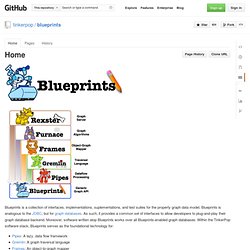
Blueprints is analogous to the JDBC, but for graph databases. As such, it provides a common set of interfaces to allow developers to plug-and-play their graph database backend. Moreover, software written atop Blueprints works over all Blueprints-enabled graph databases. Within the TinkerPop software stack, Blueprints serves as the foundational technology for:
Thinkaurelius/titan. A Well-Woven Study of Graphs, Brains, and Gremlins. SMI32-stained pyramidal neurons in the cerebral cortex.

Provided by UC Regents Davis under Creative Commons Attribution 2.5 License What do graphs and brains have in common? First, they both share a relatively similar structure: Vertices/neurons are connected to each other by edges/axons. Second, they both share a similar process: traversers/action potentials propagate to effect some computation that is a function of the topology of the structure. If there exists a mapping between two domains, then it is possible to apply the processes of one domain (the brain) to the structure of the other (the graph). The Rosetta Stone of Graphs Before diving specifically into graphs and brains, its important to see that at a certain level of generality, many real-world structures are graphical in form.
“The term connectionism is usually applied to neural networks. In the article, Dr. Why are brains interesting for those doing software engineering, data management, and information retrieval? Home - GitHub. What is PEGASUS? Overview PEGASUS is a Peta-scale graph mining system, fully written in Java.

It runs in parallel, distributed manner on top of Hadoop. Hadoop is a cloud computing platfrom, as well as an open source implementation of MapReduce framework which was originally designed for web-scale data processing by Google. PEGASUS provide large scale algorithms for important graph mining tasks: • Degree • PageRank • Random Walk with Restart (RWR) • Radius • Connected Components The details of PEGASUS can be found in the following paper: U Kang, Charalampos E.
Tsourakakis, and Christos Faloutsos. Running Large Graph Algorithms - Evaluation of Current State-of-the-Art and Lessons Learned. On the surface nothing appears more different than soft data and hard raw materials like iron.
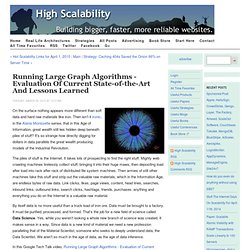
Then isn’t it ironic, in the Alanis Morissette sense, that in this Age of Information, great wealth still lies hidden deep beneath piles of stuff? It's so strange how directly digging for dollars in data parallels the great wealth producing models of the Industrial Revolution. The piles of stuff is the Internet.
It takes lots of prospecting to find the right stuff. Mighty web crawling machines tirelessly collect stuff, bringing it into their huge maws, then depositing load after load into rack after rack of distributed file system machines. Hadoop's tremendous inefficiency on graph data management (and how to avoid it) Hadoop is great.
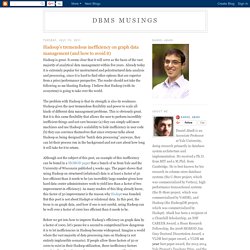
It seems clear that it will serve as the basis of the vast majority of analytical data management within five years. Already today it is extremely popular for unstructured and polystructured data analysis and processing, since it is hard to find other options that are superior from a price/performance perspective. The reader should not take the following as me blasting Hadoop. I believe that Hadoop (with its ecosystem) is going to take over the world. The problem with Hadoop is that its strength is also its weakness. Welcome To Apache Incubator Giraph. Graph-database.org.
Data Recipes. SNAP: Stanford Network Analysis Project. Graph Theory: Part III (Facebook) In the first and second parts of my series on graph theory I defined graphs in the abstract, mathematical sense and connected them to matrices.
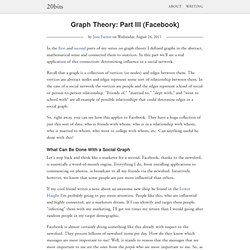
In this part we'll see a real application of this connection: determining influence in a social network. Recall that a graph is a collection of vertices (or nodes) and edges between them. The vertices are abstract nodes and edges represent some sort of relationship between them. In the case of a social network the vertices are people and the edges represent a kind of social or person-to-person relationship. "Friends of," "married to," "slept with," and "went to school with" are all example of possible relationships that could determine edges in a social graph. So, right away, you can see how this applies to Facebook. What Can Be Done With a Social Graph Let's step back and think like a marketer for a second. If my cool friend writes a note about an awesome new shop he found in the Lower Haight I'm probably going to pay more attention. Or Conclusion. Golden Orb. Pregel. Many practical computing problems concern large graphs.

Graph Theory: Part II (Linear Algebra) This is the second part in my series on graph theory.
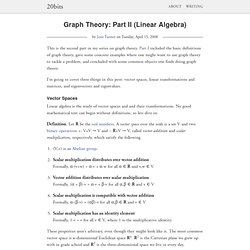
Part I included the basic definitions of graph theory, gave some concrete examples where one might want to use graph theory to tackle a problem, and concluded with some common objects one finds doing graph theory. I'm going to cover three things in this post: vector spaces, linear transformations and matrices, and eigenvectors and eigenvalues.
Vector Spaces Linear algebra is the study of vector spaces and and their transformations. No good mathematical text can begin without definitions, so lets dive in: Definition. These properties aren't arbitrary, even though they might look like it. Graph Theory: Part I (Introduction) This is the first in a multi-part series about graph theory here on 20bits.
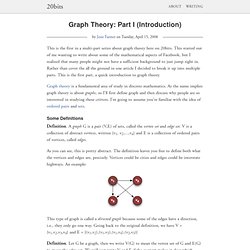
This started out of me wanting to write about some of the mathematical aspects of Facebook, but I realized that many people might not have a sufficient background to just jump right in. Rather than cover the all the ground in one article I decided to break it up into multiple parts.